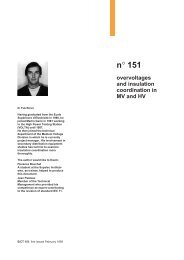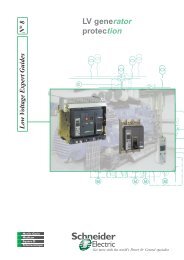sepam 20 user manual - Schneider Electric
sepam 20 user manual - Schneider Electric
sepam 20 user manual - Schneider Electric
Create successful ePaper yourself
Turn your PDF publications into a flip-book with our unique Google optimized e-Paper software.
PE50031<br />
DE51674<br />
Installation LPCT type current sensors<br />
CLP1 LPCT sensor<br />
CAUTION<br />
HAZARD OF NON-OPERATION<br />
b Set the microswitches for the CCA670/<br />
CCA671 connector before commissioning the<br />
device.<br />
b Check that only one microswitch is in position 1<br />
for each block L1, L2, L3 and that no microswitch<br />
is in the center position.<br />
b Check that the microswitch settings on all 3<br />
blocks are identical.<br />
Failure to follow these instructions can cause<br />
incorrect operation.<br />
PCRED301005EN - 06/<strong>20</strong>08<br />
Function<br />
Low Power Current Transducer (LPCT) type sensors are voltage-output sensors,<br />
which are compliant with the IEC 60044-8 standard.<br />
The <strong>Schneider</strong> <strong>Electric</strong> range of LPCTs includes the following sensors: CLP1, CLP2,<br />
CLP3, TLP160 and TLP190.<br />
CCA670/CCA671<br />
connector<br />
Function<br />
The 3 LPCT sensors are connected to the CCA670 or CCA671 connector on the rear<br />
panel of Sepam.<br />
The connection of only one or two LPCT sensors is not allowed and<br />
causes Sepam to go into fail-safe position.<br />
The two CCA670 and CCA671 interface connectors serve the same purpose,<br />
the difference being the position of the LPCT sensor plugs:<br />
b CCA670: lateral plugs, for Sepam series <strong>20</strong> and Sepam series 40<br />
b CCA671: radial plugs, for Sepam series 80.<br />
Description<br />
1 3 RJ45 plugs to connect the LPCT sensors.<br />
2 3 blocks of microswitches to set the CCA670/CCA671 to the rated phase current<br />
value.<br />
3 Microswitch setting/selected rated current equivalency table (2 In values per<br />
position).<br />
4 9-pin sub-D connector to connect test equipment (ACE917 for direct connector or<br />
via CCA613).<br />
Rating of CCA670/CCA671 connectors<br />
The CCA670/CCA671 connector must be rated according to the rated primary<br />
current In measured by the LPCT sensors. In is the current value that corresponds<br />
to the rated secondary current of 22.5 mV. The possible settings for In are (in A): 25,<br />
50, 100, 125, 133, <strong>20</strong>0, 250, 3<strong>20</strong>, 400, 500, 630, 666, 1000, 1600, <strong>20</strong>00, 3150.<br />
The selected In value should be:<br />
b entered as a Sepam general setting<br />
b configured by microswitch on the CCA670/CCA671 connector.<br />
Operating mode:<br />
1. Use a screwdriver to remove the shield located in the "LPCT settings" zone; the<br />
shield protects 3 blocks of 8 microswitches marked L1, L2, L3.<br />
2. On the L1 block, set the microswitch for the selected rated current to "1" (2 In<br />
values per microswitch).<br />
b The table of equivalencies between the microswitch settings and the selected<br />
rated current In is printed on the connector<br />
b Leave the 7 other microswitches set to "0".<br />
3. Set the other 2 blocks of switches L2 and L3 to the same position as the L1 block<br />
and close the shield.<br />
6/19<br />
6

















